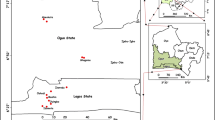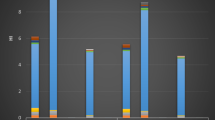Abstract
Snacks or junk foods are a form of relatively small, packaged, ready-to-eat fast foods, usually taken not as a regular, but as a stopgap. However, contamination of snacks with trace elemental impurities may pose serious health risk to consumers. The main objective of the present study is to assess the toxicological risk of trace elements TEs (Co, Cu, Fe, and Zn) in commonly consumed snack/junk foods from Ijebu Ode, Ogun State, Southwest, Nigeria. A total of sixty snack food samples were purchased and assayed in replicates for Co, Cu, Fe, and Zn using atomic absorption spectrophotometer. Trace elements data were manipulated for simple descriptive and inferential statistics. The toxicological risk of metals was estimated for average daily dose (ADD), hazard quotient (HQ), hazard index (HI), and cancer risk (CR). Results showed Fe as the most abundant TE in the snacks showing insignificant mean concentrations (p > 0.05) varying from 38.10 ± 1.98 mg kg−1 (potato chip) to 71.25 ± 14.68 mg kg−1 (cashew nut). Cashew nut had the highest amounts of the TEs. The HQs of Co in all the snacks except corn flakes consumed by children were greater than the threshold limit of 1.0, indicating non-carcinogenic adverse effects. The CRs of Co in all the food samples exceeded the acceptable limit of 1.0 × 10−4, suggesting possible development of cancer by the consumers. Co is a trace metal of health issues in the snack/junk foods. This study therefore recommends periodic monitoring and toxicological assessment of metals in snacks, especially the raw materials and processing feedstocks.

Similar content being viewed by others
Data Availability
All data generated or analyzed during this study are included in this published article [and its supplementary information files].
References
Kausik J, Narang M, Parakh A (2011) Fast food consumption in children. Indian Pediatric 48(2):97–110
Smith L (2012) Junk foods and junk moods. Incredible Messages Press, Pittsburgh, pp 71–85
Ogunfowokan AO, Morakinyo MK, Agboola OS, Durosinmi LM (2005) Levels of lead and cadmium in some Nigerian confectionery wrappers. J Appl Sci 5:1032–1035
Iwegbue CM, Nwozo SO, Chukwudumebi LO (2013) Concentrations of selected metals in some ready-to-eat- foods consumed in southern Nigeria: estimation of dietary intakes and target hazard quotient. Turk J Agric Food Sci Technol 1(1):1–7
Taiwo AM, Aigbodion CO, Ojekunle OZ, Akinhanmi TF (2020) Health risk assessment of metals in selected drinks from Abeokuta, southwestern Nigeria. Biol Trace Elem Res 197:694–707
Nkwunonwo UC, Odika PO, Onyia NI (2020) A review of the health implications of heavy metals in food chain in Nigeria. The Sci World J 2020:1–11. https://doi.org/10.1155/2020/6594109
Liu L, Luo XB, Ding L, Luo SL (2019) Application of nanotechnology in the removal of heavy metal from water. In: Nanomaterials for the Removal of Pollutants and Resource Reutilization. Elsevier, Amsterdam, pp 83–147
Jurowski K, Szewczyk B, Nowak G, Piekoszewski W (2014) Biological consequences of zinc deficiency in the pathomechanisms of selected diseases. JBIC J Biol Inorg Chem 19(7):1069–1079
Jurowski K, Krośniak M, Fołta M, Tatar B, Cole M, Piekoszewski W (2019) The analysis of Cu, Mn and Zn content in prescription food for special medical purposes and modified milk products for newborns and infants available in Polish pharmacies from toxicological and nutritional point of view. J Trace Elem Med Biol 53:144–149
Jurowski K, Krośniak M, Fołta M, Tatar B, Cole M, Piekoszewski W (2019) The toxicological analysis of Ni and Cr in prescription food for special medical purposes and modified milk products for babies in infancy available in pharmacies in Poland. Biol Trace Elem Res 192(2):129–135
Taiwo AM, Awomeso JA (2017) Assessment of trace metal concentration and health risk of artisanal gold mining activities in Ijeshaland, Osun State Nigeria —Part 1. J Geochem Expl 177:1–10
PatrickIwuanyanwu K, Udowelle N (2017) Dietary exposure and health risk assessment of toxic and essential metals in Plantain from selected communities in Rivers State, Nigeria. J Environ Occup Sci 6(2):51–57
Soetan OC, Oyewole OE (2010) The importance of mineral element for humans, domestic animals and plants: a review. Afri J Food Sci 4(5):200–222
Ekpo KO, Asia IO, Amayo KO, Jegede DA (2008) Determination of Pb, Cd and Hg in surrounding water and organs of some species of fish in Ikpoba river in Benin City, Nigeria. Int J Phys Sci 3(11):289–292
Tangahu BV, Sheikh Abdullah SR, Basri H, Idris M, Anuar N, Mukhlisin M (2011) A review on heavy metals (As, Pb, and Hg) uptake by plants through phytoremediation. Int J Chem Eng 2011:1–32. https://doi.org/10.1155/2011/939161
Taiwo AM, Awomeso JA, Taiwo OT, Oremodu BD, Akintunde OO, Ojo NO, Elegbede OO, Olanrewaju HH, Arowolo TA (2017) Assessment of health risks associated with road dusts in major traffic hotspots in Abeokuta metropolis, Ogun state, southwestern Nigeria. Stoch Environ Res Risk Assess 31(2):431–447
Iwegbue C (2012) Metal contents in some brands of biscuits consumed in southern Nigeria. Am J Food Technol 7:160–167
Elham-Elshewey HAF, Radwan M (2015) Assessment of some heavy metals in some fast foods in Kalubia Governorate. Int J Res in Health Sci Nurs 1(2):71–93
Taiwo AM, Aluko EA, Babalola OO (2010) Investigations into the teratogenic potentials of lead in pregnant rabbit. Int J Biol Chem Sci 4(3):809–814
Duruibe JO, Ogwuegbu MO, Egwurugwu JN (2007) Heavy metal pollution and human biotoxic effects. Int J Phys 5:112–118
Dada EO, Njoku KL, Osuntoki AA, Akinola MO (2016) Heavy metal remediation potential of a tropical wetland earthworm, Libyodrilus violacues (Beddard). Iran J Energy Environ 7(3):247–254
Ray S, Ray M (2009) Bioremediation of heavy metal toxicity with special reference to cadmium. Al Ameen J Med Sci 2(2):57–63
WHO/FAO Codex Alimentarius Commission (2011) Joint FAO/WHO standards programme codex committee on contaminants in foods, fifth session. Working document for information and use in discussions related to contaminants and toxins in the GSCTFF codex alimentary commission, Vialedelle Terme di Caracalla Rome, Italy
Vračko P, Tuomisto J, Grad J, Kunsele E (2007) Exposure of children to chemical hazards in food. World Health Organization. http://www.euro.who.int/__data/assets/pdf_file/0003/97446/4.4.pdf?ua=1. Accessed: 26/12/2020
Dada EO, Ojo ON, Njoku KL, Akinola MO (2017) Assessing the levels of Pb, Cd, Zn and Cu in biscuits and home-made snacks obtained from vendors in two tertiary institutions in Lagos, Nigeria. J Appl Sci Environ Manage 21(3):521–524
Oyelola,OI, Afolabi MI, Ajibosun IO, Banjoko IO (2013) Heavy metal and microbial contents of roadside roasted corn and plantain in Alimosho local government area of Lagos State, Nigeria. Int J Res Med Health Sci 3(1): 28–32
Solidum JN, Parel JL, Pascual A, Reyes R, Tiga DJ (2013) Quantitative analysis of lead, cadmium and chromium in different brands of junk food marketed in metro Manila, Philippines. Adv Mater Res 634:1581–1585 Trans Tech Publications Ltd
Adimula VO, Onianwa PC, Ilupeju O, Ayom E, Baba AA (2019) Assessment of heavy metals in foods and adult dietary intake estimates. Afr J Sci Technol Innov Dev 11(2):261–268
AOAC International (ed) (2000) Official methods of analysis, 20th edn. AOAC International, Gaithersburg, MD, USA
Taiwo AM, Beddows DCS, Calzolai G, Harrison RM, Lucarelli F, Nava S, Shi Z, Valli G, Vecchi R (2014) Receptor modelling of airborne particulate matter in the vicinity of a major steelworks site. Sci Tot Environ 490:488–500
USEPA (2001) United States Environmental Protection Agency risk assessment guidance for superfund: process for conducting probabilistic risk assessment (Part A); EPA 540-R-02-002; USEPA: Washington, DC, USA, Volume 3. https://www.epa.gov/risk/risk-assessment-guidance-superfund-rags-volume-iii-part. Accessed: 18-10-2020
USEPA (2002) Integrated risk information system (IRIS) database. National Center for Environmental Assessment, Washington DC
USEPA (2007) United States Environmental Protection Agency, framework for metal risk assessment, EPA 120-R-07-001, Washington DC, 2007
EPA (2016) Cobalt Compounds https://www.epa.gov/sites/production/files/2016-09/documents/cobalt-compounds.pdf. Accessed: 26-12-2020
Salama A, Radwan M (2005) Heavy metals (Cd, Pb) and trace elements (Cu, Zn) contents in some foodstuff from the Egyptian market. Emir J Food Agric 17:34–42
Lenntech (2020) Chemical properties of copper - Health effects of copper - Environmental effects of copper. https://www.lenntech.com/periodic/elements/cu.htm#ixzz6hjEYg44c. Accessed: 26/12/2020
IOM (Institute of Medicine) (2001) Dietary reference intakes for vitamin A, vitamin K, arsenic, boron, chromium, copper, iodine, iron, manganese, molybdenum, nickel, silicon, vanadium, and zinc. National Academy Press, Washington, DC, pp 442–501
Arigbede OE, Olutona GO, Dawodu MO (2019) Dietary intake and risk assessment of heavy metals from selected biscuit brands in Nigeria. J Heavy Met Toxic Dis 4:1–15
Hala SH, Shireen MN (2009) Estimation of some heavy metals in chicken shawarma. Egypt J Comp Pathol Clin Pathol 22(3):24–36
ATSDR (2005) Toxic substances portal - zinc. https://www.atsdr.cdc.gov/phs/phs.asp?id=300&tid=54. Accessed: 26/12/2020
Olivares M, Walter T, Hertrampf E, Pizarro F (1999) Anaemia and iron deficiency disease in children. Brit Med Bullet 55(3):534–543
Taiwo AM, Oyeleye OF, Majekodunmi BJ, Anuobi VE, Afolabi SA, Idowu OE, Ojekunle ZO, Taiwo OT (2019) Evaluating the health risk of metals (Zn, Cr, cd, Ni, Pb) in staple foods from Lagos and Ogun states, southwestern Nigeria. Environ Monit Assess 191(3):1–11
Taiwo AM, Gbadebo AM, Awomeso JA (2010) Potability assessment of selected brands of bottled water in Abeokuta, Nigeria. J Appl Sci Environ Manage 14(3):47–52
Ayantobo OO, Awomeso JA, Oluwasanya GO, Bada BS, Taiwo AM (2014) Gold mining in Igun-Ijesha, Southwest Nigeria: impacts and implications for water quality. Am J Environ Sci 10(3):289–300
Prashanth L, Kattapagari KK, Chitturi RT, Baddam VRR, Prasad LK (2015) A review on role of essential trace elements in health and disease. J NTR Univ Health Sci 4(2):75–85
WHO (2020) Micronutrient deficiencies. https://www.who.int/nutrition/topics/ida/en/. Accessed: 20-10-2020
ATSDR (Agency for Toxic Substances and Disease Registry) (2015) Public health statement for cobalt. Atlanta, GA: U.S. Department of Health and Human Services, Public Health Service. https://www.atsdr.cdc.gov/az/h.html. Accessed: 21-10-2020
Tomori WB, Onibon VO (2015) Health risk assessment of metal content in wheat-based snacks from three different kitchen types in Akure metropolis. FUTA J Res Sci 1:157–170
Iwegbue CM, Ojelum AL, Bassey FI (2014) A survey of metal profiles in some traditional alcoholic beverages in Nigeria. Food Sci Nutr 2(6):724–733
Angelé-Martínez C, Goodman C, Brumaghim J (2014) Metal-mediated DNA damage and cell death: mechanisms, detection methods, and cellular consequences. Metallomic 6(8):1358–1381
Onyenucheya A (2018) Lagos, foundation partner on childhood cancer. https://guardian.ng/features/lagos-foundation-partner-on-childhood-cancer/. Accessed: 21-10-2020
Jedy-Agba E, Curado MP, Ogunbiyi O, Oga E, Fabowale T, Igbinoba F, Adebamowo CA (2012) Cancer incidence in Nigeria: a report from population-based cancer registries. Cancer Epidemiol 36:e271–e278
WHO (2018) Cancer. https://www.who.int/news-room/fact-sheets/detail/cancer. Accessed: 03-11-2020
Acknowledgements
The authors are grateful to Mr. O. A. Babatunde of the Department of Environmental Management and Toxicology, Federal University of Agriculture, Abeokuta for the laboratory assistance provided during this study.
Funding
No funds, grants, or other support was received.
Author information
Authors and Affiliations
Corresponding author
Ethics declarations
Conflict of Interest
The authors declare that they have no conflict of interest.
Additional information
Publisher’s Note
Springer Nature remains neutral with regard to jurisdictional claims in published maps and institutional affiliations.
Supplementary Information
ESM 1
(DOCX 36 kb)
Rights and permissions
About this article
Cite this article
Taiwo, A.M., Olukayode, S., Ojekunle, O.Z. et al. The Toxicological Risk Assessment of Trace Elements (Co, Cu, Fe, and Zn) in Snacks from Ijebu Ode, Ogun State, Southwest, Nigeria. Biol Trace Elem Res 199, 4847–4855 (2021). https://doi.org/10.1007/s12011-021-02576-7
Received:
Accepted:
Published:
Issue Date:
DOI: https://doi.org/10.1007/s12011-021-02576-7




